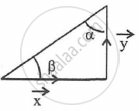Advertisements
Advertisements
Question
The angles of a triangle, two of whose sides are represented by the vectors `sqrt(3)(veca xx vecb)` and `vecb - (veca.vecb)veca` where `vecb` is a non-zero vector and `veca` is a unit vector are ______.
Options
`tan^-1(1/sqrt(3)); tan^-1(1/2); tan^-1((sqrt(3) + 2)/(1 - 2sqrt(3)))`
`tan^-1(sqrt(3)); tan^-1(1/sqrt(3)); cot^-1(0)`
`tan^-1(sqrt(3)); tan^-1 (2) tan^-1((sqrt(3) + 2)/(2sqrt(3) - 1))`
`tan^-1(sqrt(3)); tan^-1 (sqrt(2)) tan^-1((sqrt(2) + 3)/(3sqrt(2) - 1))`
Solution
The angles of a triangle, two of whose sides are represented by the vectors `sqrt(3)(veca xx vecb)` and `vecb - (veca.vecb)veca` where `vecb` is a non-zero vector and `veca` is a unit vector are `underlinebb(tan^-1(sqrt(3)); tan^-1(1/sqrt(3)); cot^-1(0))`.
Explanation:
Let `vecx = sqrt(3)(veca xx vecb)` and `vecy = vecb - (veca.vecb)veca` clearly `vecx.vecy` = 0 `\implies vecx` and `vecy` are perpendicular
So, one angle is `π/2`. Also `|vecx| = sqrt(3)|b sin θ|`, where θ is angle between vectors `veca` and `vecb (|veca| = 1)`
`|vecy| = sqrt({vecb - (veca.vecb)veca}^2) = sqrt(b^2 - (veca.vecb)^2`

= `sqrt(b^2 - b^2 cos θ) = |b sin θ|`
∴ `|vecx|/|vecy| = sqrt(3)` = tan α `\implies α = π/3`. So, β = `π/6`
